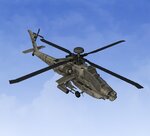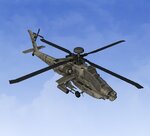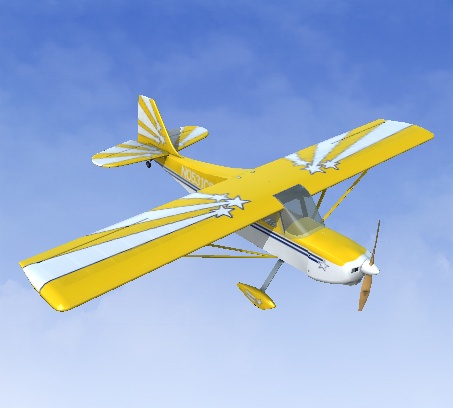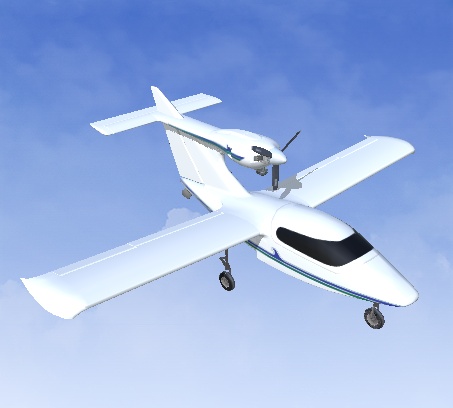Boeing AH-64 Apache
From Wikipedia, the free encyclopedia
Jump to navigation Jump to search
The Boeing AH-64 Apache (/əˈpætʃi/) is an American twin-turboshaft attack helicopter with a tailwheel-type landing gear arrangement and a tandem cockpit for a crew of two. It features a nose-mounted sensor suite for target acquisition and night vision systems. It is armed with a 30 mm (1.18 in) M230 chain gun carried between the main landing gear, under the aircraft's forward fuselage, and four hardpoints mounted on stub-wing pylons for carrying armament and stores, typically a mixture of AGM-114 Hellfire missiles and Hydra 70 rocket pods. The AH-64 has significant systems redundancy to improve combat survivability.
The Apache began as the Model 77 developed by Hughes Helicopters for the United States Army's Advanced Attack Helicopter program to replace the AH-1 Cobra. The prototype YAH-64 was first flown on 30 September 1975. The U.S. Army selected the YAH-64 over the Bell YAH-63 in 1976, and later approved full production in 1982. After purchasing Hughes Helicopters in 1984, McDonnell Douglas continued AH-64 production and development. The helicopter was introduced to U.S. Army service in April 1986. The advanced AH-64D Apache Longbow was delivered to the Army in March 1997. Production has been continued by Boeing Defense, Space & Security, with over 2,400 AH-64s being produced by 2020.[3]
The U.S. Army is the primary operator of the AH-64. It has also become the primary attack helicopter of multiple nations, including Greece, Japan, Israel, the Netherlands, Singapore, and the United Arab Emirates. It has been built under license in the United Kingdom as the AgustaWestland Apache. American AH-64s have served in conflicts in Panama, the Persian Gulf, Kosovo, Afghanistan, and Iraq. Israel used the Apache in its military conflicts in Lebanon and the Gaza Strip. British and Dutch Apaches have seen deployments in wars in Afghanistan and Iraq.
Contents
Development
Advanced Attack Helicopter
Main article: Advanced Attack Helicopter
An early Hughes YAH-64 prototype with T-tail
Following the cancellation of the AH-56 Cheyenne in 1972, in favor of projects like the U.S. Air Force A-10 Thunderbolt II and the Marine Corps AV-8A Harrier, the United States Army sought an aircraft to fill an anti-armor attack role that would still be under Army command.[4][5] The 1948 Key West Agreement forbade the Army from owning combat fixed-wing aircraft. The Army wanted an aircraft better than the AH-1 Cobra in firepower, performance and range. It would have the maneuverability for terrain following nap-of-the-earth (NoE) flying.[6] To this end, the U.S. Army issued a Request For Proposals (RFP) for an Advanced Attack Helicopter (AAH) on 15 November 1972.[7][8] As a sign of the importance of this project, in September 1973 the Army designated its five most important projects as the "Big Five", with the AAH included.[9]
Proposals were submitted by Bell, Boeing Vertol/Grumman team, Hughes, Lockheed, and Sikorsky. In July 1973, the U.S. Department of Defense selected finalists Bell and Hughes Aircraft's Toolco Aircraft Division (later Hughes Helicopters). This began the phase 1 of the competition.[10] Each company built prototype helicopters and went through a flight test program. Hughes' Model 77/YAH-64A prototype first flew on 30 September 1975, while Bell's Model 409/YAH-63A prototype first flew on 1 October 1975. After evaluating the test results, the Army selected Hughes' YAH-64A over Bell's YAH-63A in 1976. Reasons for selecting the YAH-64A included its more damage tolerant four-blade main rotor and the instability of the YAH-63's tricycle landing gear arrangement.[11][12]
A YAH-64A prototype in 1982
The AH-64A then entered phase 2 of the AAH program under which three pre-production AH-64s would be built, additionally, the two YAH-64A flight prototypes and the ground test unit were upgraded to the same standard.[11] Weapons and sensor systems were integrated and tested during this time, including the laser-guided AGM-114 Hellfire missile.[13] Development of the Hellfire missile had begun in 1974, originally known by the name of Helicopter Launched, Fire and Forget Missile ('Hellfire' being a shortened acronym),[14] for the purpose of arming helicopter platforms with an effective anti-tank missile.[15][16]
I
Aircraft used by Johnatan schweizer gibson registration N199AH anti lightning realistic sound is 64%.
for Realflight RF7.5 RF9 And RF9.5 Simulator RC.
New sound: AH-64 Apache
Great enjoy. ?✈
?✈
From Wikipedia, the free encyclopedia
Jump to navigation Jump to search
| AH-64 Apache | |
|---|---|
| An AH-64 Apache from the U.S. Army's 101st Aviation Regiment in Iraq | |
| Role | Attack helicopter |
| National origin | United States |
| Manufacturer |
|
| First flight | 30 September 1975[1] |
| Introduction | April 1986[2] |
| Status | In service |
| Primary users | United States Army |
| Produced | 1975–present |
| Number built | 2,400 as of April 2020[3] |
| Variants | AgustaWestland Apache |
The Apache began as the Model 77 developed by Hughes Helicopters for the United States Army's Advanced Attack Helicopter program to replace the AH-1 Cobra. The prototype YAH-64 was first flown on 30 September 1975. The U.S. Army selected the YAH-64 over the Bell YAH-63 in 1976, and later approved full production in 1982. After purchasing Hughes Helicopters in 1984, McDonnell Douglas continued AH-64 production and development. The helicopter was introduced to U.S. Army service in April 1986. The advanced AH-64D Apache Longbow was delivered to the Army in March 1997. Production has been continued by Boeing Defense, Space & Security, with over 2,400 AH-64s being produced by 2020.[3]
The U.S. Army is the primary operator of the AH-64. It has also become the primary attack helicopter of multiple nations, including Greece, Japan, Israel, the Netherlands, Singapore, and the United Arab Emirates. It has been built under license in the United Kingdom as the AgustaWestland Apache. American AH-64s have served in conflicts in Panama, the Persian Gulf, Kosovo, Afghanistan, and Iraq. Israel used the Apache in its military conflicts in Lebanon and the Gaza Strip. British and Dutch Apaches have seen deployments in wars in Afghanistan and Iraq.
Contents
- 1 Development
- 2 Design
- 3 Operational history
- 4 Variants
- 5 Operators
- 6 Specifications (AH-64A/D)
- 7 Notable appearances in media
- 8 See also
- 9 References
- 10 External links
Development
Advanced Attack Helicopter
Main article: Advanced Attack Helicopter
An early Hughes YAH-64 prototype with T-tail
Following the cancellation of the AH-56 Cheyenne in 1972, in favor of projects like the U.S. Air Force A-10 Thunderbolt II and the Marine Corps AV-8A Harrier, the United States Army sought an aircraft to fill an anti-armor attack role that would still be under Army command.[4][5] The 1948 Key West Agreement forbade the Army from owning combat fixed-wing aircraft. The Army wanted an aircraft better than the AH-1 Cobra in firepower, performance and range. It would have the maneuverability for terrain following nap-of-the-earth (NoE) flying.[6] To this end, the U.S. Army issued a Request For Proposals (RFP) for an Advanced Attack Helicopter (AAH) on 15 November 1972.[7][8] As a sign of the importance of this project, in September 1973 the Army designated its five most important projects as the "Big Five", with the AAH included.[9]
Proposals were submitted by Bell, Boeing Vertol/Grumman team, Hughes, Lockheed, and Sikorsky. In July 1973, the U.S. Department of Defense selected finalists Bell and Hughes Aircraft's Toolco Aircraft Division (later Hughes Helicopters). This began the phase 1 of the competition.[10] Each company built prototype helicopters and went through a flight test program. Hughes' Model 77/YAH-64A prototype first flew on 30 September 1975, while Bell's Model 409/YAH-63A prototype first flew on 1 October 1975. After evaluating the test results, the Army selected Hughes' YAH-64A over Bell's YAH-63A in 1976. Reasons for selecting the YAH-64A included its more damage tolerant four-blade main rotor and the instability of the YAH-63's tricycle landing gear arrangement.[11][12]
A YAH-64A prototype in 1982
The AH-64A then entered phase 2 of the AAH program under which three pre-production AH-64s would be built, additionally, the two YAH-64A flight prototypes and the ground test unit were upgraded to the same standard.[11] Weapons and sensor systems were integrated and tested during this time, including the laser-guided AGM-114 Hellfire missile.[13] Development of the Hellfire missile had begun in 1974, originally known by the name of Helicopter Launched, Fire and Forget Missile ('Hellfire' being a shortened acronym),[14] for the purpose of arming helicopter platforms with an effective anti-tank missile.[15][16]
I
Aircraft used by Johnatan schweizer gibson registration N199AH anti lightning realistic sound is 64%.
for Realflight RF7.5 RF9 And RF9.5 Simulator RC.
New sound: AH-64 Apache
Great enjoy.









